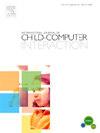社交和好奇:为幼儿设计数字教具的经验
Q1 Social Sciences
International Journal of Child-Computer Interaction
Pub Date : 2025-02-17
DOI:10.1016/j.ijcci.2025.100725
引用次数: 0
摘要
向幼儿介绍数字素养(DL),包括计算思维(CT),可以培养他们在计算机科学、解决问题和批判性思维方面的基本技能。然而,目前用于展示计算思维策略的数字玩具并不总是为早期环境或专门为年幼(学龄前)儿童设计的。结合嵌入式计算的数字操作可以提供适合儿童发展的工具,在儿童为更正式的编程活动做好发展准备之前,介绍基本的编程策略和动态系统知识。本文在学龄前儿童(3-5岁)的环境中进行了一项实证研究,在学龄前儿童主导的免费和有指导的游戏活动中使用了新型数字操纵性工具,即嵌入式工具(embedables)(图1)。通过对儿童参与的活动类型的分析,我们发现了数字操纵性工具未被充分开发的设计特征,这些特征可以通过有趣的和认知性的游戏建立早期CT技能的暴露。这些是设计行为,分布式交互,人工制品之间的条件和近端关系,以及抽象的多感官反应。本文章由计算机程序翻译,如有差异,请以英文原文为准。
Social and curious: Lessons in designing digital manipulatives for young children
Introducing Digital Literacy (DL), including Computational Thinking (CT), to young children develops foundational skills in computer science, problem-solving, and critical thinking. However, current digital toys for demonstrating computational thinking strategies are not always designed for early-year environments or specifically for young (preschool) children. Digital manipulatives incorporating embedded computation can offer developmentally appropriate tools to introduce foundational programming strategies and dynamic system knowledge before children become developmentally ready for more formalised programming activities. This paper presents an empirical study in a preschool environment with children (aged 3–5 years) using novel digital manipulatives, Embeddables, in child-led free and guided play activities in a preschool (Fig. 1). From our analysis of the types of activities the children engaged in, we identified underexplored design features of digital manipulatives that can build early exposure to CT skills through ludic and epistemic play. These are designed-in behaviour, distributed interactivity, conditional and proximal relations between artefacts, and abstracted multisensorial reactions.
求助全文
通过发布文献求助,成功后即可免费获取论文全文。
去求助
来源期刊

International Journal of Child-Computer Interaction
Social Sciences-Education
CiteScore
7.20
自引率
0.00%
发文量
73
 求助内容:
求助内容: 应助结果提醒方式:
应助结果提醒方式:


